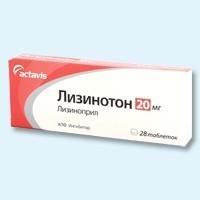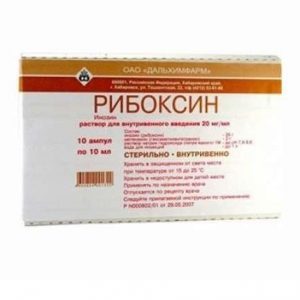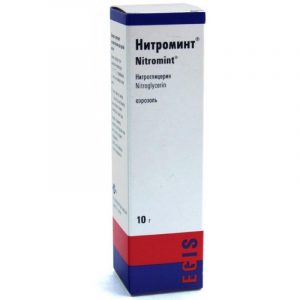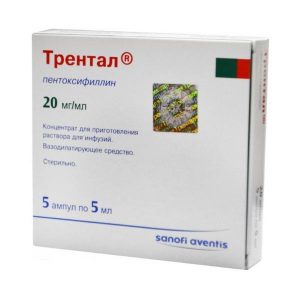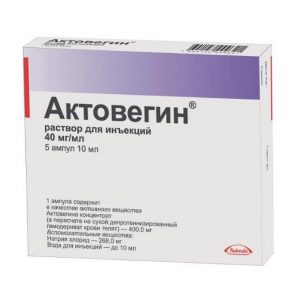Description
Packing
14 pcs – blisters (2) – packs of cardboard.
Pharmacological action
Lysinotone, an ACE inhibitor, reduces the formation of angiotensin II from angiotensin I. A decrease in angiotensin II leads to a direct decrease in aldosterone excretion. Reduces the degradation of bradykinin and increases the synthesis of prostaglandins. It reduces OPSS, blood pressure, preload, pressure in the pulmonary capillaries, causes an increase in minute blood volume and increased myocardial tolerance to stress in patients with chronic heart failure. Expands arteries to a greater extent than veins. Some effects are explained by the effect on tissue renin-angiotensin systems. With prolonged use, hypertrophy of the myocardium and walls of the arteries of the resistive type decreases. Improves blood supply to the ischemic myocardium.
ACE inhibitors lengthen life expectancy in patients with chronic heart failure, slow the progression of left ventricular dysfunction in patients after myocardial infarction without clinical manifestations of heart failure.
After a single dose of the drug, the antihypertensive effect develops after 1 hour, reaches a maximum after 6-7 hours and persists for 24 hours. The duration of the effect also depends on the size of the dose taken. With arterial hypertension, the effect is observed in the first days after the start of treatment, a stable effect develops after 1-2 months. With a sharp withdrawal of the drug, no marked increase in blood pressure was observed.
Lysinotone reduces albuminuria. In patients with hyperglycemia, it helps normalize the function of damaged glomerular endothelium. It does not affect the blood glucose concentration in patients with diabetes mellitus and does not lead to an increase in cases of hypoglycemia.
Indications
– Arterial hypertension (as monotherapy or in combination with other antihypertensive drugs).
– Chronic heart failure (as part of combination therapy for patients taking digitalis and / or diuretics).
– An early period of acute myocardial infarction (in the first 24 hours) with stable hemodynamics (to maintain hemodynamic parameters and prevent left ventricular dysfunction and heart failure).
Contraindications
– History of angioedema (including when using ACE inhibitors).
– Hereditary Quincke’s edema.
– Age under 18 years of age (efficacy and safety not established).
– Hypersensitivity to lisinopril or other ACE inhibitors.
With caution, the drug should be prescribed for severe renal dysfunction, bilateral renal artery stenosis or single stenosis of the artery of a single kidney with progressive azotemia, a condition after kidney transplantation, renal failure, azotemia, hyperkalemia, aortic stenosis, hypertrophic obstructive hyperemia, hypertrophic hypertension, cerebrovascular diseases (including cerebrovascular insufficiency), coronary heart disease, coronary deficiency, autoimmune systemic diseases of the connective tissue (including scleroderma, systemic lupus erythematosus), inhibition of bone marrow hematopoiesis, hypovolemic conditions (including as a result of diarrhea, vomiting) to patients on a diet with a sodium restriction, elderly patients.
Use during pregnancy and lactation
The use of lisinotone during pregnancy is contraindicated. Lisinopril crosses the placenta. When pregnancy is established, the drug should be discontinued as soon as possible. Acceptance of ACE inhibitors in the II and III trimesters of pregnancy has an adverse effect on the fetus (a pronounced decrease in blood pressure, renal failure, hyperkalemia, skull hypoplasia are possible, fetal death). There are no data on the negative effects of the drug on the fetus if used in the first trimester. For newborns and infants who underwent intrauterine exposure to ACE inhibitors, it is recommended to establish careful monitoring to timely detect a pronounced decrease in blood pressure, oliguria, hyperkalemia.
There is no data on the absorption of lisinopril into breast milk. If necessary, the appointment of the drug during lactation, breastfeeding should be discontinued.
Dosage and administration
– Arterial hypertension For arterial hypertension, patients not receiving other antihypertensive drugs are prescribed 5 mg 1 time / day. If there is no effect, the dose is increased every 2-3 days by 5 mg to an average therapeutic dose of 20-40 mg / day (increasing the dose of more than 40 mg / day usually does not lead to a further decrease in blood pressure). The usual daily maintenance dose is 20 mg. The maximum daily dose is 40 mg. The full effect usually develops after 2-4 weeks from the start of treatment, which should be taken into account when increasing the dose. With insufficient clinical effect, it is possible to combine the drug with other antihypertensive drugs. If the patient received preliminary treatment with diuretics, then their reception must be stopped 2-3 days before the start of the use of lisinotone. If it is impossible to cancel diuretics, then the initial dose of Lysinotone should not exceed 5 mg / day. In this case, after taking the first dose, medical monitoring is recommended for several hours (the maximum effect is achieved after about 6 hours), because a marked decrease in blood pressure may develop.
– Renovascular hypertension In case of renovascular hypertension or other conditions with increased activity of the renin-angiotensin-aldosterone system, it is also advisable to prescribe a lower initial dose – 2.5-5 mg / day under enhanced medical supervision (control of blood pressure, kidney function, potassium concentration in blood serum) . The maintenance dose should be determined depending on the dynamics of blood pressure.
– Renal failure In renal failure due to the fact that lisinopril is excreted through the kidneys, the initial dose should be determined depending on the clearance of creatinine, then, in accordance with the reaction, a maintenance dose should be established under conditions of frequent monitoring of renal function, serum potassium and sodium concentrations.
– Chronic heart failure In chronic heart failure, the initial dose is 2.5 mg 1 time / day, followed by a dose increase of 2.5 mg 3-5 days before the usual maintenance daily dose of 5-20 mg. The daily dose should not exceed 20 mg.
– Elderly patients. Elderly patients often have a more pronounced long-term hypotensive effect, which is associated with a decrease in the rate of elimination of lisinopril. Therefore, in this category of patients, it is recommended to begin treatment with a dose of 2.5 mg / day.
– Acute myocardial infarction In acute myocardial infarction (as part of combination therapy), 5 mg are prescribed on the first day, then – 5 mg every other day, 10 mg – after two days and then 10 mg 1 time / day. In patients with acute myocardial infarction, the drug should be used for at least 6 weeks. At the beginning of treatment or during the first 3 days after acute myocardial infarction in patients with low systolic blood pressure (? 120 mm Hg), the drug should be prescribed in a dose of 2.5 mg. In the case of a decrease in blood pressure (systolic blood pressure? 100 mm Hg) while taking Lisinoton, the daily dose of 5 mg can be temporarily reduced to 2.5 mg. In the case of a prolonged marked decrease in blood pressure (systolic blood pressure
Side effects of
From the cardiovascular system: often – orthostatic hypotension, chest pain (1-3%) rarely (<1%) - marked decrease in blood pressure, palpitations, tachycardia, myocardial infarction, cerebrovascular stroke in patients with increased the risk of the disease, due to a pronounced decrease in blood pressure. From the side of the central nervous system: often – dizziness, headache (5-6%), weakness rarely (<1%) - increased fatigue, drowsiness, convulsive twitching of the muscles of the limbs and lips, asthenic syndrome, mood lability, confusion, decreased potency. From the digestive system: often – nausea, vomiting, diarrhea rarely (<1%) - dry mouth, anorexia, dyspepsia, taste changes, abdominal pain, pancreatitis, hepatocellular or cholestatic jaundice, hepatitis. From the respiratory system: often (3%) – dry cough. From the hemopoietic system: possibly – leukopenia, neutropenia, agranulocytosis, thrombocytopenia, with prolonged treatment – a slight decrease in the concentration of hemoglobin and hematocrit, erythrocytopenia. On the part of the immune system: (0.1%) angioedema (face, lips, tongue, larynx or epiglottis, upper and lower extremities) rarely (<1%) - a syndrome that includes an acceleration of ESR, arthralgia, and the appearance of antinuclear antibodies. From the urinary system: rarely (<1%) - impaired renal function, oliguria, anuria, acute renal failure, uremia, proteinuria. Dermatological reactions: often – skin rash is rare (< 1%) - urticaria, increased sweating, skin itching, alopecia. Laboratory indicators: hyperkalemia, azotemia, hyperuricemia, hyperbilirubinemia, increased activity of hepatic enzymes (especially if there is a history of kidney disease, diabetes mellitus, and renovascular hypertension). Other: rarely (<1%) - myalgia, fever, impaired fetal development. º °Ñ ÑÑ ² ½ ½ ¾ ² · ° ¸ ¼ ¾ ´ ¹ÑÑ ² ¸ Ñ ¸ ¾ ´ ½ ¾ ²Ñ ¼ ½ ½ ¾ ¼ ¿Ñ ¸ ¼ ½ ½ ¸ ¸ Ñ ´ ¸ÑÑ Ñ ¸ º ° ¼ ¸ » ¸ · ¸ ½ ¾ ¿Ñ ¸ » Ñ ¼ ½ÑÑ ° Ñ ² ² ´ ½ ¸ º ° » ¸Ñ. ¡ ¾Ñ ¾ ± ¾ ¹ ¾ÑÑ ¾Ñ ¾ ¶ ½ ¾ÑÑ ÑÑ Ñ » ´Ñ Ñ ½ ° · ½ °Ñ °Ñ Ñ ¸ · ¸ ½ ¾Ñ ¾ ½ ¾ ´ ½ ¾ ²Ñ ¼ ½ ½ ¾ Ñ º ° » ¸ ¹Ñ ± Ñ ³ °ÑÑ ¸ ¼ ¸ ´ ¸ÑÑ Ñ ¸ º ° ¼ ¸ (Ñ ¿ ¸Ñ ¾ ½ ¾ » ° ºÑ ¾ ½, Ñ Ñ ¸ ° ¼Ñ Ñ ½, ° ¼ ¸ » ¾Ñ ¸ ´), º ° » ¸ ¼, · ° ¼ ½ ¸Ñ »Ñ ¼ ¸ Ñ ¾ » ¸, Ñ ¾ ´ Ñ ¶ °Ñ ¸ ¼ ¸ º ° » ¸ ¹, Ñ . º. ¿ ¾ ² Ñ ° Ñ ÑÑ Ñ ¸Ñ º Ñ ° · ² ¸Ñ ¸Ñ ³ ¸ ¿ Ñ º ° » ¸ ¼ ¸ ¸, ¾Ñ ¾ ± ½ ½ ¾ ¿Ñ ¸ ½ °Ñ ÑÑ ½ ½ ¾ ¹ ÑÑ ½ ºÑ ¸ ¸ ¿ ¾Ñ º. ¾ÑÑ ¾ ¼Ñ ´ ° ½ ½ º ¾ ¼ ± ¸ ½ °Ñ ¸ ¸ Ñ » ´Ñ Ñ ½ ° · ½ °Ñ °Ñ Ñ Ñ ¾ »Ñ º ¾ ½ ° ¾Ñ ½ ¾ ² ¸ ½ ´ ¸ ² ¸ ´Ñ ° »Ñ ½ ¾ ³ ¾ Ñ Ñ ½ ¸Ñ » Ñ °Ñ ³ ¾ ²Ñ °Ñ ° ¿Ñ ¸ Ñ ³Ñ »ÑÑ ½ ¾ ¼ º ¾ ½Ñ Ñ ¾ » ÑÑ ¾ ² ½Ñ º ° » ¸Ñ ² Ñ ² ¾Ñ ¾Ñ º ºÑ ¾ ² ¸ ¸ ÑÑ ½ ºÑ ¸ ¸ ¿ ¾Ñ º. Ñ ¸ ¾ ´ ½ ¾ ²Ñ ¼ ½ ½ ¾ ¼ ¿Ñ ¸ ¼ ½ ½ ¸ ¸ Ñ ´ ¸ÑÑ Ñ ¸ º ° ¼ ¸ ¸ ´Ñ Ñ ³ ¸ ¼ ¸ ° ½Ñ ¸ ³ ¸ ¿ Ñ Ñ ½ · ¸ ² ½ ¼ ¸ ¿Ñ ¿ °Ñ °Ñ ° ¼ ¸ Ñ ° · ² ¸ ² ° Ñ ÑÑ ° ´ ´ ¸Ñ ¸ ² ½ ¹ ° ½Ñ ¸ ³ ¸ ¿ Ñ Ñ ½ · ¸ ² ½ ¹ ÑÑÑ ºÑ . Ñ ¸ ¾ ´ ½ ¾ ²Ñ ¼ ½ ½ ¾ ¼ ¿Ñ ¸ ¼ ½ ½ ¸ ¸ Ñ ¡ ( ² Ñ .Ñ. Ñ ¸ ½ ´ ¾ ¼ Ñ °Ñ ¸ ½ ¾ ¼), ÑÑÑ Ñ ¾ ³ ½ ° ¼ ¸, ° Ñ ° º ¶ ° ´Ñ ½ ¾ÑÑ ¸ ¼Ñ »ÑÑ ¾Ñ ° ¼ ¸ Ñ ½ ¸ ¶ ° Ñ ÑÑ ° ½Ñ ¸ ³ ¸ ¿ Ñ Ñ ½ · ¸ ² ½ ¾ ´ ¹ÑÑ ² ¸ » ¸ · ¸ ½ ¾ ¿Ñ ¸ » °. Ñ ¸ ¾ ´ ½ ¾ ²Ñ ¼ ½ ½ ¾ ¼ ¿Ñ ¸ ¼ ½ ½ ¸ ¸ Ñ » ¸Ñ ¸ ¼ ² ² ´ ½ ¸ » ¸Ñ ¸Ñ ¼ ¾ ¶ Ñ Ñ ¼ ½ÑÑ ¸Ñ ÑÑÑ, ¿ ¾ÑÑ ¾ ¼Ñ Ñ » ´Ñ Ñ Ñ ³Ñ »ÑÑ ½ ¾ º ¾ ½Ñ Ñ ¾ » ¸Ñ ¾ ² °Ñ Ñ º ¾ ½Ñ ½Ñ Ñ °Ñ ¸Ñ » ¸Ñ ¸Ñ ² Ñ ² ¾Ñ ¾Ñ º ºÑ ¾ ² ¸. Ñ ¸ ¾ ´ ½ ¾ ²Ñ ¼ ½ ½ ¾ ¼ ¿Ñ ¸ ¼ ½ ½ ¸ ¸ Ñ ° ½Ñ °Ñ ¸ ´ ° ¼ ¸ ¸ º ¾ » ÑÑ ¸Ñ ° ¼ ¸ ½ ¾ ¼ Ñ ½ ¸ ¶ ° Ñ ÑÑ ²Ñ °Ñ ² ° ½ ¸ » ¸ · ¸ ½ ¾ ¿Ñ ¸ » ° ¸ · ¢. Ñ ¸ ¾ ´ ½ ¾ ²Ñ ¼ ½ ½ ¾ ¼ ¿Ñ ¸ ¼ ½ ½ ¸ ¸ ÑÑ ° ½ ¾ » ÑÑ ¸ » ¸ ² ° Ñ ´ ¹ÑÑ ² ¸ » ¸ · ¸ ½ ¾ ¿Ñ ¸ » °. Overdose Symptoms: severe BP, dry mouth, drowsiness, delayed urination, constipation, anxiety, increased irritability (occur when taking a single dose of 50 mg). Treatment: carry out symptomatic therapy, if necessary (in / into the introduction of fluid, control and normalization of blood pressure, water-electrolyte balance). Lisinopril is excreted by hemodialysis. Storage conditions The drug should be stored out of the reach of children at a temperature not exceeding 25 ° C. Expiration 3 years. Deystvuyuschee substances lisinopril Pharmacy Prescription dosage form dosage form tablets Actavis Ltd, Iceland
